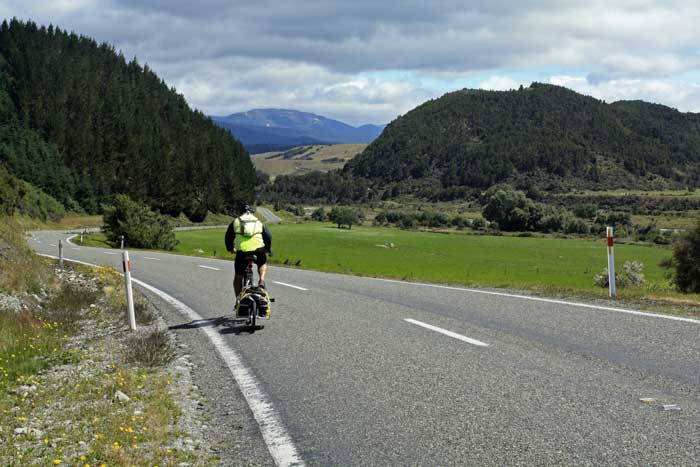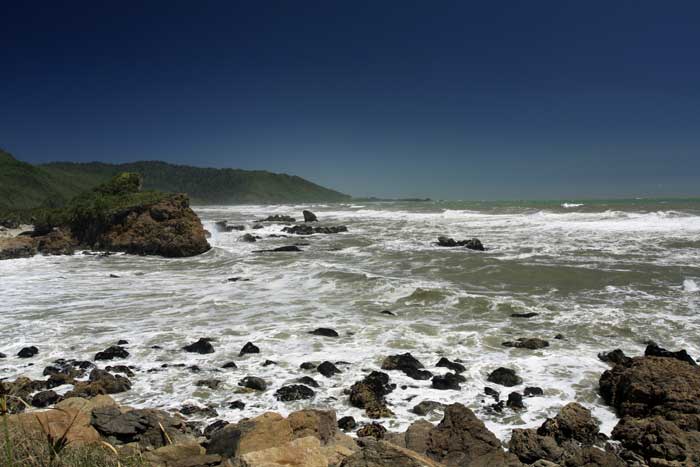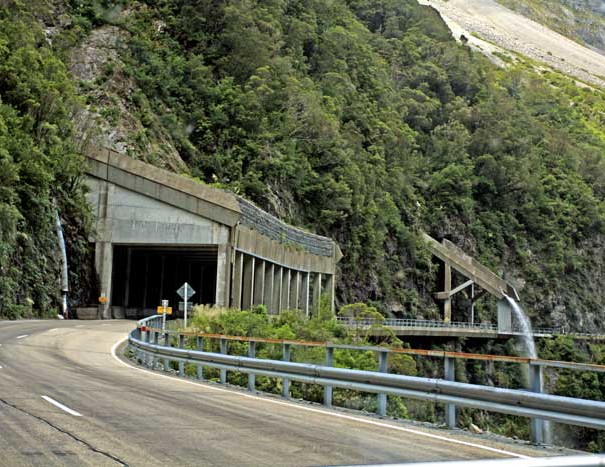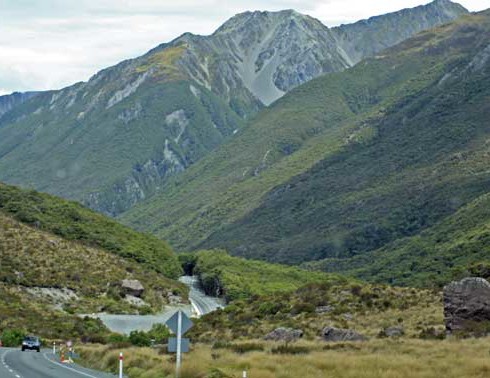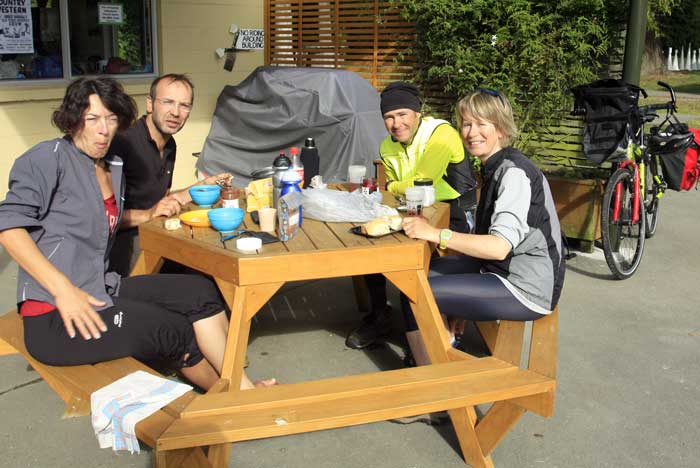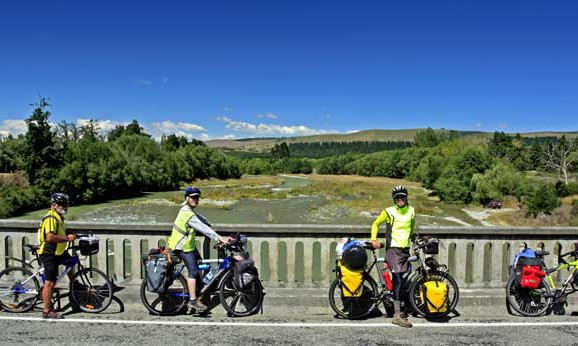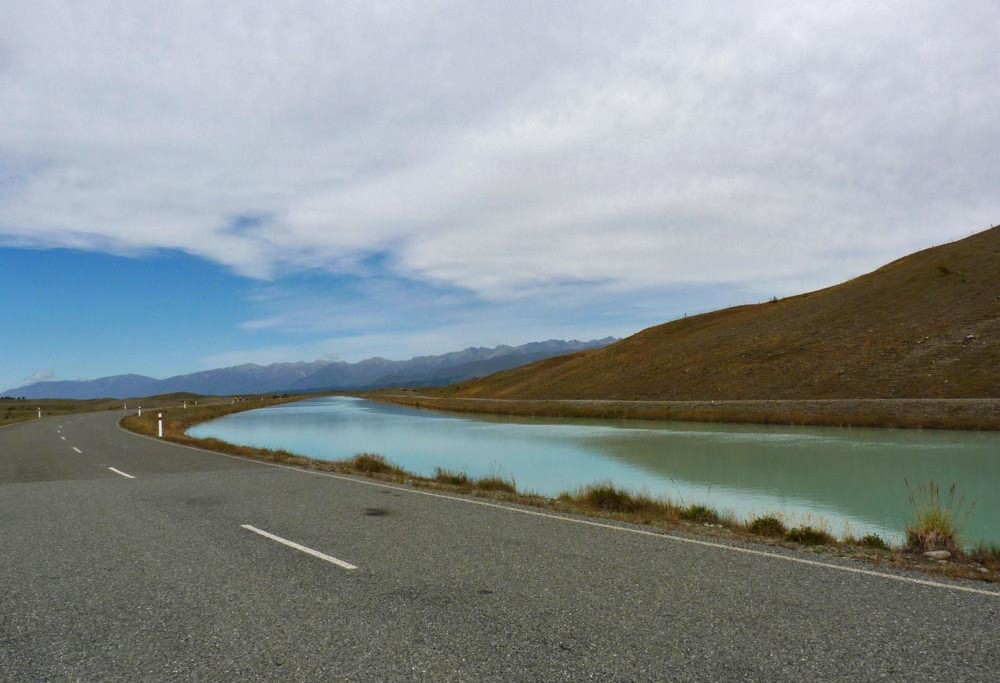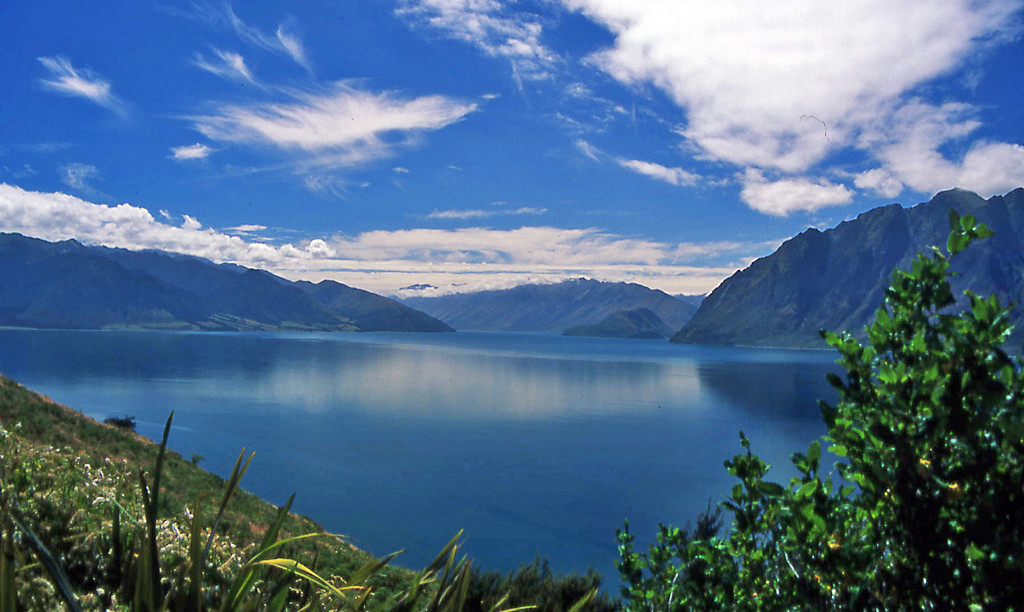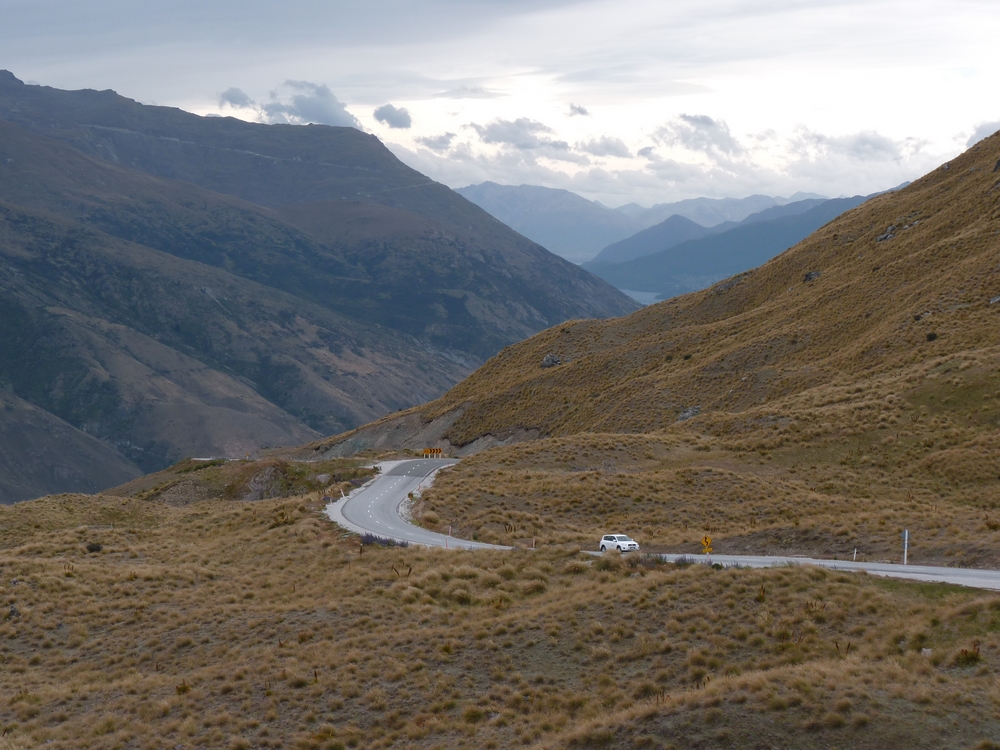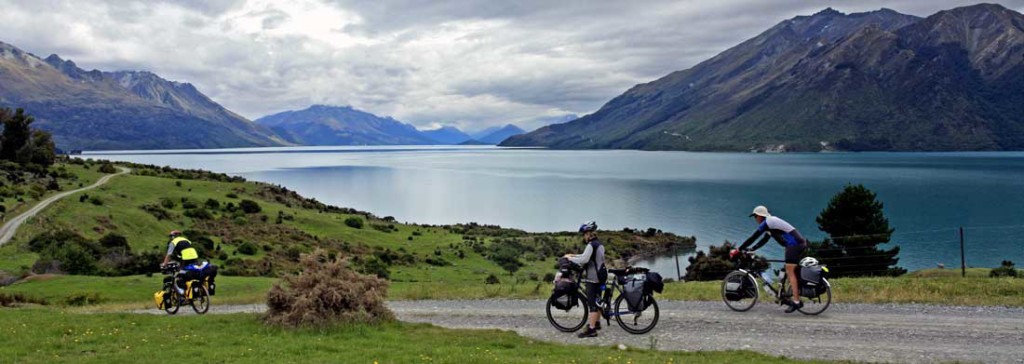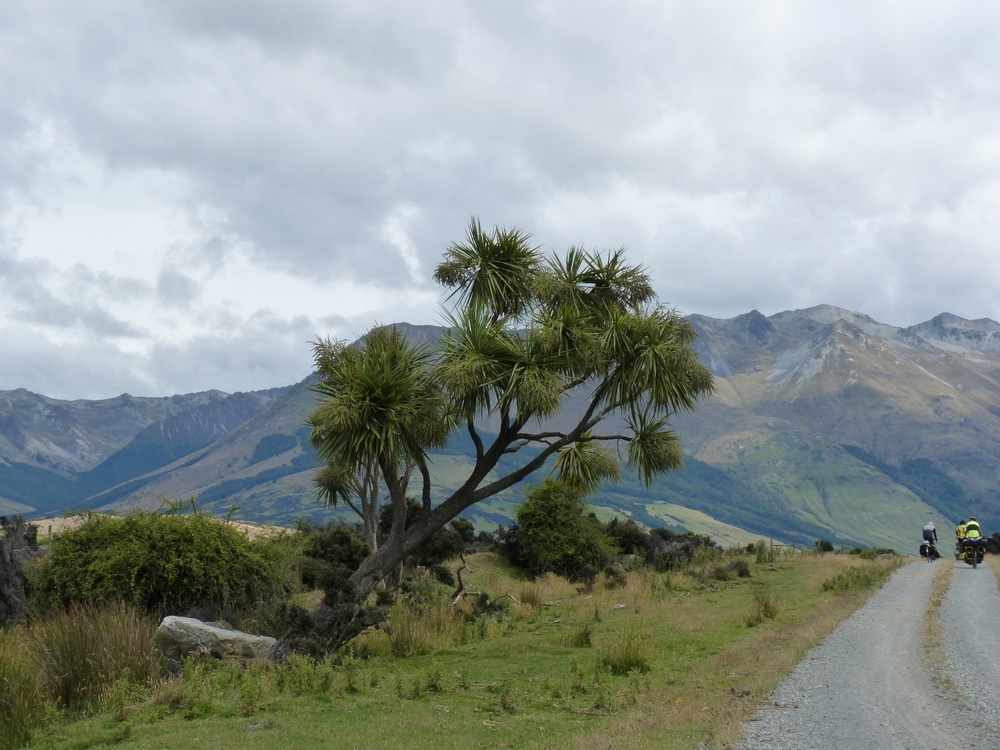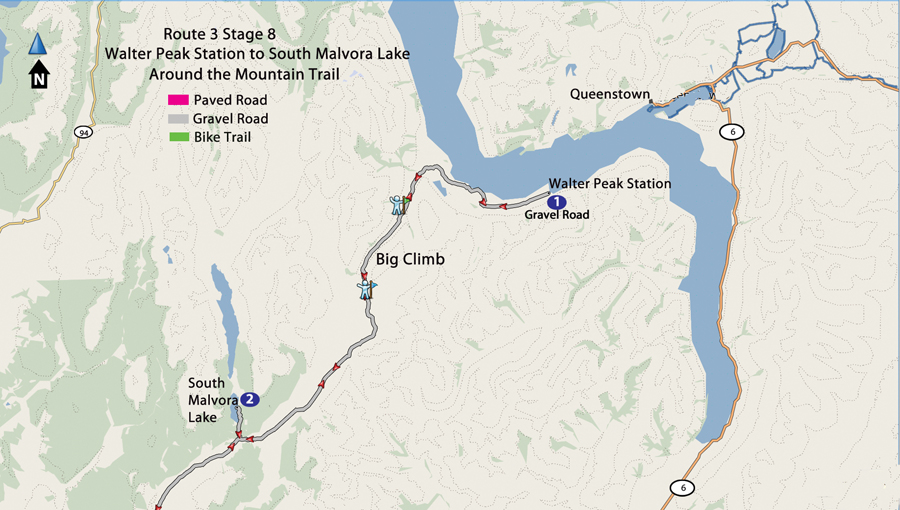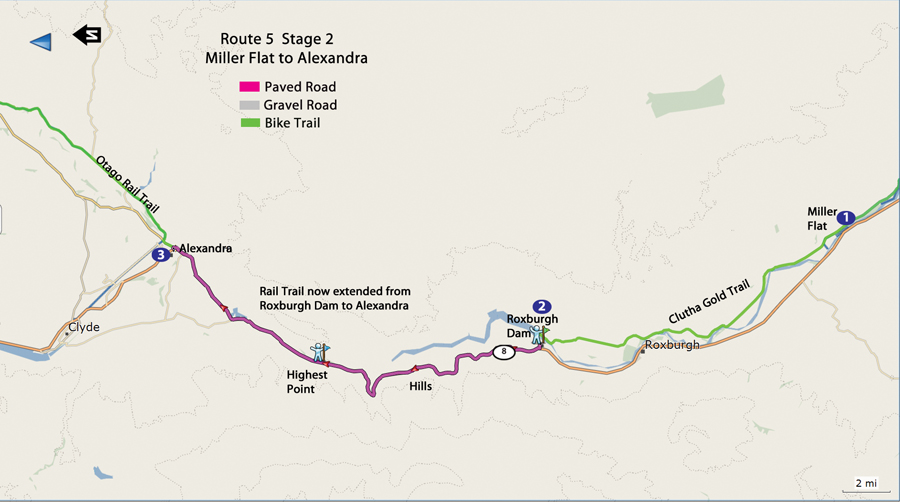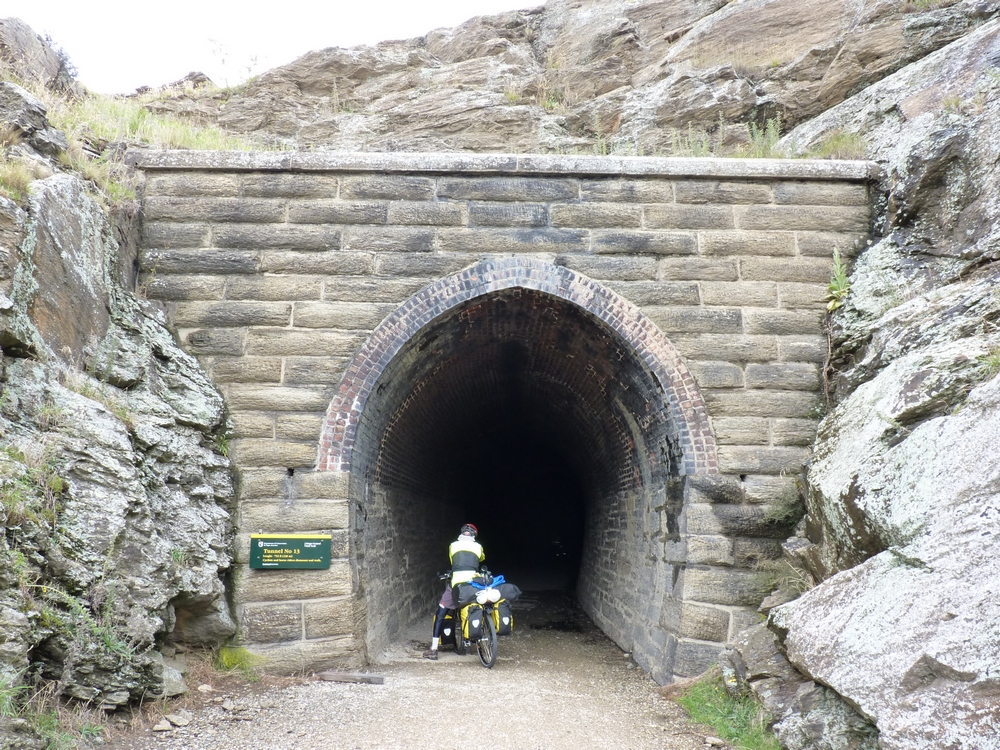
Bicycling South Island
New Zealand
Page Contents
- New Zealand
- Route 1-Picton to Westport-7 stages-197 miles
- Route 2-Westport to Geraldine-6 stages-263 miles
- Route 3-Geraldine to Te Anau-9 Stages-406 miles
- Route 4-Southern Scenic Route-7 Stages-230 miles
- Route 5-Balclutha to Pukerangi -9 Stages-188 miles
- Balclutha to Alexandra-Up the Clutha River
- The Otago Rail Trail-Alexandra to Middlemarch
- Day 1-Alexandra to Omakau-18 miles
- Day 2-Omakau to Oturehua-18 miles
- Day 3-Oturehua to Ranfurly-16 miles
- Day 4-Ranfurly to Hyde-19 miles
- Day 5-Hyde to Middlemarch-17 miles
- For GPX files, maps, profiles and descriptions of the cycling routes on this web page
- choose between our print book in black & white on Amazon.com
- or our full-color digital guide available as a download directly from our website.
Going from the North to South Island, New Zealand is almost like traveling to a different country. The language is the same, but everything else seems different.
The North Island volcanic hills are a mixture of undulations that don’t seem to have a rhythm or reason.
South Island is volcanic and glacial. The valleys are carved long and wide, the peaks deeply fractured by ice, the broad rivers plunge, and braid and plow their way to the ocean.
The staggering vistas are like the expanses of Alaska.
For cyclists,
there are important differences between
bicycling South Island New Zealand and North Island
Because of the glaciers, the inland ascents are long and sustained, but not as often as steep.
Wind direction and velocity can make or break your day. Those long, broad valleys act as wind tunnels; the wide open expanses offer no place to hide.
The coastlines are rugged, undulating, and each harbors its own weather. It is useless to plan where weather and wind are concerned.
There is less traffic overall.
The attitude of the Kiwi driver also changes from North to South. They consistently gave us plenty of space; if they could not move into the other lane, they slowed down and waited behind us.
We gave them a thank you wave; they waved back. It all seemed so balanced.
One more important feature about South Island: Many of the roads, for some reason, have a much better seal (more tar in the mix) which makes maintaining momentum a lot easier!
When it comes to road resistance, South Island has better quality paving.
When you combine all of the above, there are a ton of routes to choose from on the South Island. Depending on fitness, sense of adventure, and tolerance for radically changing weather, just about every road on the map offers a reason to cycle it.
After touring here twice, we published New Zealand: Favorite Scenic Bicycle Touring Routes.
The contents of this web page highlight selections from 5 routes for South Island that are detailed in our book.
We took the beautiful ferry ride from Wellington, North Island to Picton, South Island. It is a very picturesque town that serves as the jumping off point for our bicycle tour. The town lies at the head of the incredibly scenic Queen Charlotte Sound.
Bicycling South Island New Zealand
Route 1-Picton to Westport-7 stages-197 miles
Picton/Havelock/Renwick/St Arnaud/Murchison/Inangahua/Westport
Renwick is a fine stop on the cyclists’ route. The wine country is mostly flat and rich with vineyards. Wine tasting is a tradition at many of the wineries. The town has created a cycle route; many places rent bikes with specific panniers designed to carry wine bottles! Some of the routes are on the major highway (which has no shoulder) but other sections they have actually built a wide shoulder just for tourists. It makes for a fun day riding from one winery to another and tasting a variety of really good wine.
We discover Watson’s Way Backpackers, a purpose built hostel with 1st class amenities and a delightful ambiance. They are full, but welcome us to camp in their yard and use the facilities.
Cyclists beware!
The only respite for the day came in the pleasant form of the only pub on route: The Wairau Valley Tavern served up the most massive burger we have ever eaten!
We were unable
We had a choice. Christmas Day cleared. We could hike up to the top of Mt Roberts and get a Bird’s eye view of glacial Lake Rotoiti, or use the day to get that much closer to Westport.
Heavy rain and strong winds were still in the forecast and we did not like being at such a cold elevation. We decided to ride.
It was time for the long 100 mile descent to Westport to begin. The wide open valley of the Upper Buller River was scenically delightful. Traffic was nil and the ever present headwinds tolerable. The downhill grade was so gentle, we coasted without braking. A more enticing peddlers’ paradise could not exist. Why do we cycle the hard days? It’s all part of the adventure, and makes the good days that much better.
St Arnaud to Westport-Buller River Scenic Route
3 days of thrilling river canyon-about 100 miles
The Buller River is South Island’s largest drainage. It meanders slowly at first, braided by independent minded branches that mix and separate. The road huddles nearby with sumptuous views of a pastoral Nirvana. The Buller carves through several canyons; the first begins in earnest and we find ourselves buffeted by winds that don’t know which way to blow. Come around a corner, get knocked sideways, or struggle against the straight on force. Still, the river flows, a perfect passage way for canoes or kayaks, as we climb and descend over crags and bluffs.
Two Maori passed this way in 1847 on a 550 day journey from Nelson to Westport and back. My God! How did they do it!
Traffic picks up when we reach Kawatiri Junction and the road from Nelson. Cars are in their usually hurry to somewhere, missing the fine scenery as they speed by. Do they realize what they have in their own back yard? Sometimes I wonder. We move along, sometimes soaring, other times plodding, but the river is always there to steel our attention. We make our destination and camp at a new caravan park 5 miles east of Murchison.–
It’s 60 more miles to Westport with no place to bail out if the weather turns.
We debate taking the bus as predictions offer severe weather warnings. But the day dawns calm and friendly, so we decide to ride. Though we will lose 800 feet in total elevation, there are plenty of short hills that must be climbed in low gear. Once again, the Buller accompanies our efforts. The canyon narrows from here; the mountain sides rise straight up from the road; ferns smother the cliffs. The rain seems willing to delay its assault upon us.
We have a fine ride and decide to stop for the night at Berlin Cafe, 18 miles short of Westport.
We want to save the infamous Buller Canyon for a fresh day.
We are lucky. We pass through the gorge and reach Westport just hours before landslides and high water close the road.
Bicycling South Island New Zealand
Route 2-Westport to Geraldine-6 stages-263 miles
Westport/Punakaiki/Greymouth/Arthur’s Pass/Springfield, Rakaia Gorge/Geraldine
We arrived at Punakaiki (Pancake Rocks Park) early afternoon.
Suddenly, there are tourists everywhere. Where did they come from? Not many passed us all day. The cafes at the park entrance are stuffed with visitors. We pass on the $4.50 single scoop ice cream cone and look for lodging. The Backpackers on the beach wants us to pay $40 for a “tent site” under the laundry line behind the building. The Caravan Park across the street is full, but willing to break the rules of 200 total campers. We get a patch of grass for $30. Soon the “open area” is filled to capacity with late comers.
Punakaiki National Park
The wind has diminished by morning; we take the time to walk the paths around the pancake rock formations before the hordes of tourists arrive. This stretch of coastline is worth the effort to get there. Mother Nature has created a unique environment of sea and rock; man has built access to it.
The most scenic section of the entire west coast highway
is between Westport and Greymouth
Bicycling South Island New Zealand
The Challenge and Beauty of Arthur’s Pass Route
Greymouth to Springfield-115 miles-climb 5995 feet of elevation-3 days
We found the Mountain House Hostel for the night. It had a pot belly stove to keep us warm and a cozy, traditional atmosphere. The Arthur’s Pass Store and Cafe had a reasonable selection of groceries.
We would have stayed at Arthur’s Village at least another day to do one of the scenic walks in the area. Since more rain was forcast, we were grateful for the clear morning so we could cycle the spectacular east side of the route in the sunshine.
Of all the places we have cycled in the world, this stretch may be our favorite.
From Springfield, it is only 36 miles to Methven. We speed through the first 8 miles in fifteen minutes. We are on the flattest terrain we have seen in New Zealand! Then, we turn the corner and head into the wind. We did not make it to Methven. We grind through the town called Windwhistle.
It’s the place where the northwest winds battle for supremacy against the southwest winds.
Suddenly, the road drops fiercely into Rakaia Gorge. Even the strong winds cannot prevent our coasting. What a relief. The gorge is a scenic beauty and there just happens to be one of the loveliest campsites in New Zealand overlooking the river.
The aggressive climb out of the gorge into the thrashing wind did not seem like fun.
The Kiwi campers offered to drive us into Methven for needed groceries. The decision to stay was easy. We pitched our tent on the grassy knoll above the river while the wind continued to howl. The sun was hot, the view fantastic, and happy hour circle started at 5pm.
It was one of our favorite days.
There is not much man made to see from Rakaia Gorge to Geraldine. Mount Somers and the Peel Forest are crafted by nature. Mt Hut looms on our right side all day. Fields of grass with sheep and cows flank the stark hillsides. It is peaceful; there is hardly any traffic; the road is pancake flat. We cruise against the gentler breeze of the day. Only Mayfield, a three shop town, and a café with gourmet delicacies all by itself suggest human interference. We arrive in Geraldine with energy to spare. What a rare feeling!
Geraldine makes the delicious jam we have been buying since on the South Island. It’s a small town of 2100 folks that exudes charm without the heavy commercial tourism feeling. The movie theater has couches instead of seats on the main floor. The only caravan park is brimming with Kiwi holiday makers on the last days before school starts, but we are given a quiet site with a picnic table. The hostess offered us the use of frying pans (which we do not carry) and a key to a kitchen locker where we could store our food.
Here gathered the newly arrived cyclists. Post New Years, suddenly there they were. Arriving in Christ Church from their respective countries, they made their way to Geraldine in preparation for their assault on the South Island. We all met in the kitchen. French, Japanese, English and German couples and singles. Since the rain started again that night, and lasted three days, we all got to know each other well.
A new adventure was about to begin.
Bicycling South Island New Zealand
Route 3-Geraldine to Te Anau-9 Stages-406 miles
Geraldine/Fairlie/Tekapo/Twizel/Mt Cook/Wanaka/Queenstown/Malvora Lake/Te Anau
Four French, two Japanese, two Brits and two German cyclists, along with us, gathered in the camp kitchen at Geraldine Holiday Park to wait out three days of rain. They had all cycled separately from Christchurch and were taking the same route to Mt Cook when the rain bunched us all together.
One of the perks of cycling New Zealand is meeting international tourists with the same penchant for independent travel.
The rain stops. Stephanie and Fabrice and we decide to cycle together as long as we are going the same pace and the same direction.
They are easy company and bring a fresh perspective to our view of adventuring.
The route from Geraldine to Mt Cook is a long, barely noticeable ascent through Fairlie, Lake Tekapo to Lake Pukaki and Twizel. We stop at each town, taking three days to enjoy the variety of scenery and things to do. The Southern Alps Mountains are a constant companion; the vistas are expansive like Alaska; this is a thrillingly scenic route. Traffic is heavier than we expected until realizing this is also the tourist route to Mt Cook, but most of the tour buses have passed us by mid-day.

Our best cycling day is from Lake Tekapo to Lake Pukaki. There is a road along a canal that draws water from Tekapo to Pukaki. The gradient is imperceptible, traffic is nil. We four take up the whole road and let the wind push us south. The end of the canal road drops sharply down to Lake Pukaki where we follow the shoreline for several more kilometers before entering the highway to the town; the silence of no cars allows us to hear the birds and wind.
We reach the Mt Cook turnoff with energy to spare. We passed a free camping site overlooking Lake Pukaki, but there was no water or toilet and we had not enough food to make the trip to Mt Cook. We turn opposite and cycle the remaining 6 miles to Twizel.
At the Four Square Market in Twizel, another cyclist eyes our loaded bikes with amusement. He is already camped at the Holiday Park; we end up in the next door site. Welcome Nick (English bloke) to our group of four. Later that evening, in pedal Bruno and Sylvania. Now we are seven which makes for a very enjoyable evening.
Heavy storms are again in the forecast. It is a factor in bicycling South Island New Zealand. We fear riding the 35 miles to Mt Cook may cost us our only sunny opportunity to see the mountain. Although the ride there and back is scenically wonderful, and there is a campground near the trail head, we decide not to take the chance.
We rent a car for the day which allows us to enjoy the scenery along the route and affords us time to hike up the river valley.
Clouds smother the scene that evening, and the storms begin again. Timing is everything.
Now we are seven cyclists, all going the same way from Twizel to Omarama. We lined up on the road and sped off in a tight draft. It was a brutal speed for Anne’s compromised lungs, but the suction from the draft and the smooth road helped her maintain momentum and keep her breathing and heart rate at a safe level. We blitzed the 24 miles between towns in 80 minutes. We celebrated with a Works Burger and scoop of fries. We had Lindis Pass in front of us and wanted more than granola bars for sustenance. Bruno and Sylvania turned east to the coast at Omaru. They would do the same route in the opposite direction. Hopefully we will pass each other at some point. We enjoy the camaraderie of cycling with other adventurers.
We don’t expect to cross Lindis Pass today. We stock up on water and food in preparation for camping in the wild below the pass. It is 50 miles across the top; no food or water along the route.
It was a good decision. As we five leave Omarama and enter the open, unsettled heights, a headwind blows us to a near standstill.
There are no toilets or water, and no signs to say, “Camping prohibited”. The temperature drops severely; we all don wool hats, long underwear, windbreakers, virtually all the layers we have. Dinner is soup and instant mashed potatoes (light weight food that we always carry), and bedtime comes long before dark. The wind rattles the tent all night but we are snug inside and sleep with the satisfaction of a challenge met and a good day of cycling with friends.
Dawn breaks cold: 7 degrees. It’s hard to release the warm sleeping bag and step into the brace of cold wind. Perhaps we should wait? No. Let’s get it done. It is so much easier, and more fun to meet challenges in the company of friends. We spur each other on, support and cajole our way through breakfast and packing. The sun is forbidden in our forested enclave, but outside on the road, we see its warming invitation. Still, we cycle in wool hats, tights and gloves. It is true. It is possible to experience four seasons in one day in New Zealand.
The ascent up Lindis Pass has to be one of our favorite rides. It is barren land; the pass is in view from the flat lands. The road climbs like a snake in front of us.
By afternoon, on the other side of the pass in Tarras, it is 27 degrees. Here we meet the day cyclist. At least 20 of them. They are on a tour. The coach takes them to the top of the pass; they ride down to Tarras. They look at us wrapped in our survival togs as if we came from the Antarctic. They brag about the distance they covered today on their weightless road bikes. Conversation is short lived. They pay Yuppie prices at the Tarras eateries while we munch on our dry granola bars. So doth the world revolve!
There is no camping in Tarras. The Yuppie Motel saw to that.
So, on we go to Wanaka, another 22 miles, tourist haven of the Southern Alps. It’s a long ride and finishes with a giant hill after a stream crossing. Signs leading to town promote skydiving, helicopter flights, glider flights, glacier treks, bungee jumping.
The Information site is awash with tourists begging to pay for extravagant services. All we want right now is a place to camp and a hot shower. It is only a short distance away, on the edge of town and lake. We corner a camping spot where vehicles are prohibited and set up our tents.
The lake is a picturesque gem. It is easy to stay for another day and rest.
Triathlon races all the next day offer exciting, free entertainment.
There is a choice of routes to Queenstown
We chose the yellow road on the map (Crown Range Road); it would have the least traffic. There was a good reason. The sign 10 miles from Wanaka said, “Trailers not recommended”. It was not described in our cycling book.
It is the highest paved road in New Zealand.
We rode through Cardrona, a unique old, restored pub where you could buy lunch for $24/person.
Just beyond the serious climb began. It was 6 miles of 10% plus grades.
By the time we got to the top, the wind was blowing so cold and hard; we snapped off a photo and headed down the other side. What a view of the Queenstown mountain ranges and valleys!
This is a fabulous route with superb scenery.
Entering Queenstown by bicycle is not fun. The traffic is heavy, drivers are in a hurry, and there is a deep rain gutter next to the white line. Steep, short hills and sharp curves need to be negotiated.
We heard about a gravel trail from Frankton that followed the lake shore, but no one could describe it accurately. With the heavy luggage, we stayed on the main road.
Twice, Anne’s gears did not shift into low. The second time, it over shifted off the cluster and jammed. Her speed was so slow; she had no momentum to maintain balance. She did not get her foot free fast enough and fell into the street. Knowing she was going down in traffic, she wrenched her foot out and scrambled off the road. Mike blocked the cars to give her time. It was all too scary.
We all rode the sidewalk into town after that. Welcome to Queenstown!
Queenstown has San Francisco style hills. After cycling down to the lake edge, and tourist bureau, we cycled back up to the Lakeview Holiday Park overlooking the lake. Bursting at the seams with tourists with deep pockets, the park charges the ultimate $20/person for tent space plus $2/shower. It is run like a corporation, not a friendly campground. We counted 22 different camper van rental units parked side by side; each had a view of the other’s windows.
At least it was sunny and dry.
We had a beautiful view of the Remarkables Mountains and Lake Wakatipu.
The exploration was curtailed immediately once we discovered the price to ride the gondola to the mountaintop was $25/person; a one hour tour boat on the lake was $75/person; a burger at McDonalds was $9, and a loaf of good bread at the supermarket was $6. We walked around the wharf and town and refrained from depositing our skimpy budget into the tourist coffer.
More importantly, we gathered the information we needed for the next, exciting part of our cycling journey from Queenstown to Te Anau across 60 miles of spectacular country on a little used gravel road.
Queenstown to Te Anau -Spectacular!
Mostly gravel-85 miles in two days
The gravel route to Te Anau begins with a fabulous ride across Lake Wakatipu on a restored coal fired passenger ship called the TSS Earnslaw. The ship was constructed in the early 1900’s and was the largest to work these waters. The engine room is completely visible from the lounge above. The coal fired steam engine is massive and propels the boat at 13 knots per hour. The parlor is complete with a grand saloon with piano. Tours of the ship are given on route.
There are several departures a day from Queenstown to Walter’s Peak Station.
We land at Walter Peak Station . It is a working sheep station with a beautiful lodge. Tourists come on the TSS Earnslaw on a package which includes a tour of the station and accommodation in the lodge.
After Coromandel, Anne and I had vowed to never to do dirt and gravel roads again, but here we are about to begin another adventure on gravel. Our companions, Nick, Fabrice and Stephanie stirred our adventuring spirit for another effort. We were glad they did.
The entire journey was a highlight of our travels.
For New Zealand, the road is relatively flat; the views are terrific; we ride along Lake Wakatipu and can see for miles. There is no traffic on the road, so it is more like going on a hike.
At the beginning, the surface is especially rough and jarring; none of us have suspension on our bikes; we all have road tires and heavy luggage. But it is remote, quiet, and thrilling all at once.
Rain is in the air, but we are able to outrun it for a period of time as the road heads inland and the rain moves down the lake. We follow along a river through a rugged wide canyon that leads to the high country.
We have our first stream crossing thereafter. It is possible to ride through if enough speed can be maintained, but Anne and Stephanie remove their shoes and wade across. There is another crossing a short time later, just before we start to climb. The route is wilderness with the exception of the few ranch improvements from time to time. We see two vehicles on the first day.
We start climbing the only long steep hill on the route. Our tires slip on the loose gravel which doubles our efforts to make progress. We walk portions.
After an hour top out. We are now on a large plateau where several valleys have topped out together. It is the type of terrain that one would expect to see at 12,000 to 14,000 in the U.S. and we are at only 3,000 ft.
Bicycling South Island New Zealand-Route 3-8-Walter Peak to Malvora Lake profile
The rain is coming up from all the valleys, and has us surrounded and we can feel it coming on. Our campground at Malvora Lake is approximately 2 hours away and we will be wet and cold before we arrive. The road starts to descend; the surface improves from large rock to smaller and we pick up a tailwind.
It is a long day and we arrive in camp wet and cold; Stephanie and Fabrice forego cooking; Nick’s tent has a safe cooking shelter; we brave the rain by hiding under thick trees. The strength of the storm increases throughout the night.
In the morning, we consider waiting out the wind and rain but need food so we start out with all our clothes on our backs. Much of the road is again large rock and our teeth chatter as we ride. There is some traffic on this side as far as the lake; there is washboard for the first time. The tail wind picks up to the point we must ride our brakes for long periods of time. We have not experienced this high of a tailwind before.
We arrive in Te Anau very tired and happy.
Every stage and every route on Bicycling New Zealand in this web site has accompanying maps such as you see here detailed in our Kindle and printed book: Cycle New Zealand 9 Scenic Touring Routes.
Te Anau is one of the most functional and appealing towns that we have seen in New Zealand. It is situated on one of the larger lakes in Fiordland.
There is a park system along the lake that is over a mile in length and is maintained very well. The only drawback to this perfection is that the also clean public restroom costs one dollar to enter. Mike wanted to ask the attendant what happens when a person in need does not have a dollar. He did not ask as he knows the answer. The entire town appears new. Most every property is in excellent condition with recent paint and good landscaping. There is good variety of attractive restaurants and shops. The town is a low key Wanaka.
The Te Anau Kiwi Holiday Park near the city center was one of the nicest we have stayed at, with a large complex of kitchen and lounge rooms. Once again, the weather turns very cold so we hibernate two days and plan our next adventure: The Southern Scenic Route.
Bicycling South Island New Zealand
Route 4-Southern Scenic Route-7 Stages-230 miles
Te Anau/Manapouri/Tuatapere/Riverton/Invercargill Curio Bay/Owaka/Balclutha
For a scenic route, parts of it are on the fringe of uninteresting. There is some lovely country scenery, but nothing to really stir the juices, especially after the magnificent route we took to Te Anau. We got the feeling the Chamber of Commerce called it the Southern Scenic Route just to bring more tourism to the area. There is, however, very little traffic on the route which makes it an excellent choice for a peaceful ride.
We left Te Anau early. The ride to Tuatapere was 60 miles with some big climbs. There were wide valleys and grand mountains along much of the way and we managed the biggest hill without much time or difficulty. We covered half the distance easily, with energy to spare.
Why not, we thought, take the 8 mile gravel side road to Borland Lodge and spend a night there. The lodge property had been utilized for housing by workers building one of New Zealand’s larger power plants. After the plant was constructed, it was turned into an eco study center for youth and the public in general.
There were hiking trails with a hut system, and a large, beautiful lake.
At the turn off road, we had all agreed to go to Borland for the night.
The road was in terribly condition with horrible washboard and deep gravel.
At the highway again, we are greeted by a strong headwind. We pass a school with water, bathroom and tables; a sign says, “No camping”. We seek permission from two locals to camp there as Fabrice is really hurting, but they abruptly reject any possibility. We finally make it to Tuatapere by 6:30 pm.
Tuatapere, is halfway from Te Anau to Invercargill. We were not impressed with the town itself, although it gives access to activities in Fiordland. We chose the Caravan Park right across the street from the Four Square Market. It was an unfortunate choice. The manager was rude and unpleasant. We would have left but for the late hour and more rain. We did not have the energy after a long ride against headwinds to check out the other Holiday Park. We left very early the next morning.
After Tuatapere, some of the route came back to the sea. The views of this rough coastline were very nice, although limited.
Colac Bay was especially beautiful. The tiny town had picnic benches on the beach where we enjoyed a pleasant lunch in the warm sun.
Riverton is on the coast and has a very pleasant Longwood Holiday Park where we spent the night. The property had been used for a Sunday school, Helen, the owner explained, but then the kids stopped coming so the property was sold.
Rain greeted the morning. Temperatures dropped, but it was only 24 miles to Invercargill. It is a big city, one of the southernmost cities in the world.
We found the Amble On Inn Holiday Park 5 kilometers from town. The very friendly manager let us put up our tent under the BBQ area. We had a roof, comfy chairs and were just steps away from the kitchen and bathrooms. We spent the next 2 days there sitting out another heavy rain storm. We planned our route through the Catlins in anticipation of another good section of riding.
New Zealanders are a little bit like the sheep they raise. They are exceptionally tolerant of all events that come their way, and seem to find the silver lining in every cloud; they stick together rather than forage off by themselves; a calm approach to life is more accepted than confrontation.
We were becoming less tolerant and a little more confrontational. We blamed the weather.
It is true; we were traveling the west coast and the south coast where rainfall and high winds are always going to be highest. But this La Nina year has brought the most severe weather in the last 100 years to all parts of both islands. It is useless to run away from the weather; it will change when you get to the new location. Perhaps we should adopt the New Zealanders’ attitude. After all, we are in the midst of a rare, 100 year event!
The Fabulous Catlins
We had a fine and beautiful day cycling the 45 miles from Invercargill to Curio Bay. The main highway 1 east takes all the heavy traffic while our secondary road is quiet and scenic. It rolls gently through green farmland backed by soft mountains. The south west wind was strong and pushing. We had actually timed this part right!
The sun shone all day; we arrived in the gorgeous Curio Bay early enough to enjoy walking the trails and photographing the area.
An evening visit to the penguin beach was warm and delightful.
We found a tent site with a view of the ocean, yet still protected from the strong winds by flax bush. The camp host told us that afternoon we might get, “a wee bit of rain and wind tonight.”
That evening, the remnants of another cyclone
As fierce as the cold wind blew, we found ourselves in awe of the forces before us as the violent sea crashed into the resisting rock along the cliffs.
How would we cycle onward into more of this!
By noon, the rain halted and the clouds parted. Yet, the NW wind continued to howl. It is very difficult to ride when the wind pushes sideways against the panniers. But, if we do not go, perhaps we will be standing in the shelter yet another night.
We wanted a caravan park with a closed kitchen area each night to wait out the bad weather. We packed up and headed to Owaka, 50 miles through roller coaster hills. It is a pleasant route in that there is hardly any traffic, but the hills are tough. It courses through forests, farmland, and offers occasional ocean views.
We cancelled all plans to visit the various beaches and sights along the way because they offered no shelters in which to hide.
Owaka is tiny; but there is a Four Square market. We arrived just before closing, found the Youth Hostel and set up camp before the rain began again. A large, old hospital building, the hostel became our refuge for another day. The large kitchen, living room areas offered a warm and friendly ambiance and turned a wind blown evening into a cheerful gathering with friends…Stephanie and Fabrice were already there!
More strong winds, now against us as we turned north to Balclutha,
but no rain so off we sped. Our goal was to get off the coast and head inland to Alexandra, the driest part of New Zealand and the start of the Otago Rail Trail. We barely reached the Balclutha Motor Park when torrential rains began again. We spent three days hiding in their comfortable kitchen.
Sorties to the New World Market between downpours kept us well fed.
Long days waiting out rain are ideal periods to use the internet. But, it has been frustrating at times to find a suitable source. We usually look for the library. Balclutha was large enough an industrial town to have a nice library, but they charged $3 for 15 minutes for using the internet, even if you brought your own computer. we have to milk the tourist as best we can!”
The next day, we read an article in the local paper that cemented this attitude toward the tourist. Queenstown, the undisputed tourist capital of New Zealand, was putting forth a study. They wanted to assess how much money the tourist was costing them and come up with a plan to charge additional fees to support infrastructure etc. She suggested that perhaps they are paying enough!
Balclutha to Alexandra-Up the Clutha River
We find a secondary road all the way to Beaumont. The main highway is a bit north. The scenery is rolling farmland; what makes it so serene is the lack of traffic.
It is slightly up hill all the way along the Clutha River.
The Clutha River is is a beauty.
There is no traffic; we have a tailwind.
It is one of the best routes we have found; it is not mentioned in any book we had.
A little before 3:00 we arrive at Beaumont. It is where the main highway and our quiet route come together. There is a caravan park at the pub/hotel that charges $11 per person. We check it out but decide not to stay; the facilities are very old and dirty.
We leave and head up the road toward, Millers Flat, the next caravan park and store. After a short climb, we see a very steep hill ahead; Anne remembers seeing a sign for a rail trail that went around this set of hills. We retreat to the closed pub where an information sign tells of the rail trail.
It is ambiguous as to distance to Millers Flat along this rail trail; the map on the sign shows only 9 kilometers; the rest of the distance to Miller Flat is just an arrow pointing off the map. But we decide to take this route as it is a RR grade and looked easier than the steep hills. The route (Clutha Gold Trail) turned out to be very scenic and tranquil, even though the gravel surface had big loose rocks to negotiate. There were picnic sites along the route and many opportunities for freedom camping.
We rode the 9 kilometers on this rail trail quickly; it fed into a good gravel road of undetermined distance. Clouds darkened and the inevitable rain soaked us through before we got to Miller’s Flat Holiday Park. We assembled our tent in the kitchen and staked it out when the rain gave us a break.
We had ridden over 110 kilometers; although an easy gradient, it was uphill all the way so it was very early to bed. The wind howled all night; rain pounded on the tent; by early morning, the tent of our French friends was sitting in a small lake. Luckily we had a big laundry room in which to hang everything to dry.
The next day, we finally see some sucker holes in the sky about noon. Since we have a strong pushing wind, we pack up and start the serious climb to Alexandra.
It is about 35 more miles from Millers Flat to Alexandra. The park owners tell us we can stay on the secondary road we are presently on and travel without traffic all the way to the Roxburgh Dam, 27 km; this we do. We have an unexpected tail wind and the riding is very fast without effort. We ride along the Clutha River much of the way to the Roxburgh Bridge.
We reach the town of Roxburgh within an hour. It is an additional 9 km to the dam.
Much too soon we are at the dam and it is a large one.
The land below the dam has been made into a park. We cross the dam to meet the highway and start our first real climb of the day.
After looking at the road profiles for the day we knew we were in for a tough day of climbing.
Along with the Alps, they help to protect this part of the country from the high moisture of the adjoining country.
We continue for 30 km of steep climbing and dropping with very little flat in between. Many of the single climbs are several hundred feet and by the time we are going downhill for the last time, we are completely exhausted.
This has been the hardest day of climbing for all of us and without the tail wind, would have been impossible to make before night as we were all but completely spent.
Since our trip in 2010, they have completed the Roxburgh Gorge Trail to Alexandra. It avoids the main highway and steep climbs. Instead, it follows the Clutha River through the scenic gorge. Wow!
When we reach Alexandra, the sun is out and we feel summer for the first time in many days. It seems like weeks. The town is a nice place to rest for a day or two, as it has a very nice feel to it and all the amenities that can be found in a town of over 5,000 inhabitants. This will be the largest and most enjoyable town found along the Otago Rail Trail.
The Otago Rail Trail-Alexandra to Middlemarch
The Otago Rail Trail is an example of what New Zealand government is promoting for safe and enjoyable long distance bicycling. About 80% of the thousands of people that bicycle the trail are from New Zealand. Yet, we have only met 2 long distance bikers from New Zealand while biking for the last 3 months.
It is worth it to take a day ride to Clyde. Clyde is actually the beginning of the Rail Trail. It is 8 km to the historic town and a very nice place to have a lunch at an historic tavern, or even spend the night. It is possible to take the Rail Trail to Clyde and then take an exciting single track route along the Clutha River on the return.
Staring from Alexandra, the Rail Trail is 143 km to Middlemarch. We split the journey into 5 days of cycling.
At first the gravel is very coarse and the riding quite rough, but then it mellows out soon. It is nice to be riding through the countryside without vehicle traffic. Since this is a R.R. grade, I believe the greatest slope is 2%.
The curved bridge over the Manuherikia River is a highlight as is the river itself.
The days ride is a little over 3 hours, but that is enough. We are all still exhausted from the ride to Alexandra and decide to take the next day off. The Doc campground in Omakau is large with lots of trees and good views of the countryside. There is also a newly remodeled kitchen. Most all of the folks staying here are bikers off the trail, so there is plenty to talk about. Next to the campground, there is a golf course and a grocery only 1 km away. Also a pub/hotel and a good café across the street from the pub.
There is a newspaper article in the local café, explaining that there are over 20,000 people a year that use some portion of the trail. But, probably less than 25% of the users travel the entire route of 150 km. I believe that most of the riders take from 3 to 5 days for the entire route.
The historic gold town of Ophir to the south east of Omakau is on a circular route that is well worth the extra 5 km. There are unique historic buildings and the incredible stone bridge over the Manuherikia River.
Leaving from Omakau we ride through farmlands with good views of mountain ranges in the distance. This is a pleasant scenic ride, with a lot of the scenes reminiscent of the western U.S.
In Oturehua one can visit the oldest continually operated general store in New Zealand. Gilchrist’s General Store opened in 1902.One of the most interesting and fun accommodations along the entire route is located in this town. It is the Crows Nest Accommodation and offers an array of options from camping to bunk room and private rooms in a rural setting. One is also offered the opportunity to experience a New Zealand hot tub for a small sum of $60. There must be something about the hot tub that I do not understand. In any event , the lady running the place is very cordial and accommodating. It was a very pleasant experience.
Beautiful riding through pristine countryside on a wide, traffic free gravel road is really a lot of fun!
This section of trail crosses over the highest point just before Wedderburn. It’s all downhill after that.
The old station house at Wedderburn has some wonderful photos of train travel back in the early days.
The Wedderburn shed has been restored to its original appearance.
Ranfurly is a lively town famous for its art deco buildings. There is a self guiding leaflet for an art deco walk around town that you can get from the information office.
A marvelous museum of the 30s is a highlight. Every imaginable artifact from that time period is displayed.
Although there are many interesting accommodations in Ranfurly, we stayed at the Ranfurly Holiday Park and Motel which offered the least expensive accommodation. Touted as a family park with lots of activities for children, we lucked out with a quiet night of camping on a manicured lawn.
There are more tunnels, bridges and wide open scenery as the trail follows the Taieri River to Hyde.
Hyde is a tiny rural community dominated by the Central Otago Hotel and Backpackers. It is a beautifully restored building providing lodging and food. Originally founded as a gold mining town.
The beautiful Ida Valley supports farming and grazing. Sheep! Vistas are large; the route is peaceful.
We reach Middlemarch, the end of the Otago Rail Trail.
The Middlemarch Holiday Park was the most economical place to stay. Here, we finished the Otago Rail Trail and prepared to take the famous Taieri Gorge Railway straight to the city center of Dunedin.
The cycling to Pukerangi train station from Middlemarch on Pukerangi Road was an event all by itself. There, we met the steepest of all hills we had to climb in all of New Zealand. It was a fitting end to our cycling adventure.

For GPX files, maps, profiles and descriptions of the cycling routes on this web page
choose between our print book in black & white on Amazon.com
or our full-color digital guide available as a download directly from our website.
Copyright Material
All rights reserved. No part of this page may be reproduced or utilized in any form by any means, electronic or mechanical, including downloading, print screen, photocopying, recording, or by any information storage or retrieval system, without the prior written permission by the copyright owner.

















